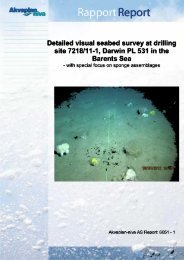A study of the priority substances of the Water Framework Directive ...
A study of the priority substances of the Water Framework Directive ...
A study of the priority substances of the Water Framework Directive ...
You also want an ePaper? Increase the reach of your titles
YUMPU automatically turns print PDFs into web optimized ePapers that Google loves.
� MCCP is medium chained chloroalkanes.<br />
� MCCP should be screened in <strong>the</strong> environment.<br />
Production and use<br />
MCCP are mainly used as plasticisers and flame<br />
retardants in paints, plastics and cutting fluids.<br />
When SCCP was banned for most purposes, <strong>the</strong><br />
use <strong>of</strong> MCCP increased. In 1995 50 tons MCCP<br />
were used in Norway; in 2002 1100 tons were<br />
used.<br />
Emissions, discharges,<br />
distribution and hot-spots<br />
The main emission source is products containing<br />
MCCP. Emissions for 1995 are not known.<br />
Emissions in 2002 are larger than 12 tons.<br />
Monitoring<br />
MCCP were screened in 2003.<br />
Marine sediment<br />
MCCP were screened in Drammensfjorden in<br />
Buskerud County and four o<strong>the</strong>r areas from<br />
Tønsberg in Vestfold County to Tromsø in<br />
Troms County. The highest levels, 7500 ng/g dry<br />
weight, were found in Drammensfjorden.<br />
Marine biota<br />
MCCP were found cod liver (Gadus morhua),<br />
but levels are generally lower than for SCCP. In<br />
blue mussels (Mytilus edulis), levels were similar<br />
to SCCP concentrations.<br />
Fresh water sediments<br />
MCCP in Mjøsa have been measured to 150-<br />
410 ng/g dry weight. The lower parts <strong>of</strong><br />
Drammenselva have four - ten times higher concentrations.<br />
Fresh water biota<br />
MCCP were found in <strong>the</strong> same concentrations<br />
as SCCP.<br />
O<strong>the</strong>r<br />
Sediments from leakage systems for municipal<br />
landfills were investigated.<br />
Hotspots<br />
Paint producers and shipyards are probable<br />
hotspots.<br />
C14-C17 chloroalkanes (MCCP) ::::::::::..<br />
g C14-C17 chloroalkanes (MCCP)<br />
FACTS<br />
MCCP are oily liquids. They are persistent, bioaccumulate<br />
in <strong>the</strong> food chain, and <strong>the</strong>y are toxic to<br />
aquatic organisms. It is uncertain whe<strong>the</strong>r MCCP is<br />
carcinogenic.<br />
Need for fur<strong>the</strong>r screening and monitoring<br />
The use <strong>of</strong> MCCP is rapidly increasing. The<br />
screening in 2003 has shown high levels. This<br />
screening should be repeated within a few years,<br />
in order to show trends.<br />
Localities for fur<strong>the</strong>r screening and monitoring<br />
The screening should be compatible with <strong>the</strong><br />
screening in 2003.<br />
Analysis<br />
With <strong>the</strong> growing interest <strong>of</strong> <strong>the</strong> analysis <strong>of</strong><br />
SCCP, <strong>the</strong> focus on MCCP has also increased.<br />
The use <strong>of</strong> SCCP has in many cases been substituted<br />
with MCCP. As for SCCP <strong>the</strong> huge<br />
amount <strong>of</strong> compounds in this group and <strong>the</strong><br />
lack <strong>of</strong> 13C-labelled internal standards is <strong>the</strong><br />
main reason that this method has not reached<br />
<strong>the</strong> same standard <strong>of</strong> analytical quality as for<br />
example <strong>the</strong> analysis <strong>of</strong> dioxins or PCB.<br />
Methods<br />
The methods are based on extraction with an<br />
organic solvent, chromatographic clean-up and<br />
separation and quantification with GC-based<br />
methods: normally GC/MS with different modes<br />
<strong>of</strong> ionization. The most prominent GC/MS<br />
methods for SCCP analyses are based on electron<br />
capture negative ion (ECNI) mode with<br />
both high- and low resolution MS. A more<br />
extensive sample clean up is necessary when<br />
using low resolution MS to remove closely related<br />
and interfering compounds. With <strong>the</strong> more<br />
sophisticated and expensive high resolution MS<br />
instruments, interferences are almost negligible.<br />
Synergy with o<strong>the</strong>r analyses<br />
Sample extraction and clean-up can be co-ordinated<br />
with <strong>the</strong> analysis <strong>of</strong> o<strong>the</strong>r persistent<br />
organic pollutants as PCB, HCH, PBDE and<br />
SCCP.<br />
A <strong>study</strong> <strong>of</strong> <strong>the</strong> <strong>priority</strong> <strong>substances</strong> <strong>of</strong> <strong>the</strong> <strong>Water</strong> <strong>Framework</strong> <strong>Directive</strong><br />
TA-2140/2005<br />
93:::..

















